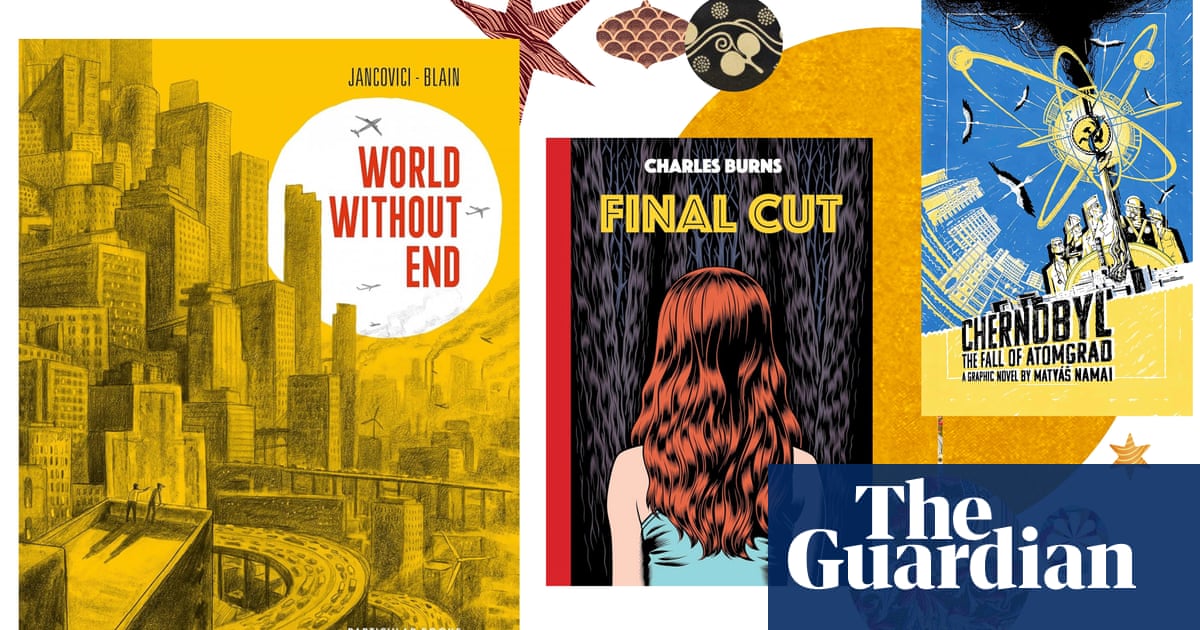British writer and illustrator Isabel Greenberg’s stellar run of graphic novels has taken in ice-bound fables and the Brontës. In this year’s thoroughly entertaining Young Hag (Jonathan Cape), a trainee witch sets out on a quest to mend the broken Excalibur and return magic to Britain. Greenberg gives Arthurian legend a feminist twist, complete with faerie tricksters, cat-riding knights and a meddling Merlin.
Art, dreams and reality form a near-seamless mesh in Final Cut (Pantheon), the unsettling and beautifully executed latest book from Black Hole creator Charles Burns. It follows Brian, an awkward young movie obsessive who lives with his alcoholic mother. He and his friends film tentacled aliens, forest trails and each other as sexual tension builds and Brian struggles to bend life to his script.
It’s been seven years since Emil Ferris introduced Karen Reyes, a young artist who thinks she’s a werewolf detective, in the first volume of My Favorite Thing Is Monsters. It was an instant classic, and this year’s Book Two (Fantagraphics) is just as good. This deeply felt, ballpoint pen-drawn gothic brick of a book, packed with detail and incident, follows Reyes as she delves deeper into family secrets and Chicago’s underworld.
GLEEM (Drawn & Quarterly) by Dominican-Canadian artist Freddy Carrasco is shorter but almost as unusual. A boy loses himself in a preacher’s sermon, a group of friends struggle to resurrect their android buddy and three clubbers seek release in short stories that flash past in a rush of shapes and sensations, trailing existential questions in their wake.
One of the year’s most talked-about releases, World Without End (translated by Edward Gauvin, Particular), outsold Astérix in its native France. Artist Christophe Blain walks us through climate expert Jean-Marc Jancovici’s urgent explanation of economic progress, sustainability and global warming in a book that’s statistics-packed but – thanks to Blain’s deceptively jaunty, eye-opening visuals – brilliantly accessible.
Sea levels are rising in Self-Esteem and the End of the World (Faber), in which Irish cartoonist Luke Healy mixes our world (its hero is cartoonist Luke Healy) with talking mice and drowned cities. Luke submerges himself in self-help podcasts, organises a disastrous team-building weekend and visits the set of a movie based on his life in a playful, funny, anxious and grief-stricken opus.
Several comics this year explored the legacy of disaster and war. Czech artist Matyás Namai’s Chernobyl: The Fall of Atomgrad (Palazzo) offers a stark and sharply styled account of the 1986 nuclear disaster. Dialogue comes from witness testimonies and historical records, while Namai’s expressive, dramatically coloured drawings show reactor mechanics, constructivist propaganda and radiation’s grim toll.
In Leela Corman’s 1940s-set Victory Parade (Schocken), New York welder Rose embarks on an affair and struggling Jewish refugee Ruth is hired to play a Nazi pantomime villain in the wrestling ring, while Rose’s husband Sam is one of the first Allied soldiers to enter the concentration camps. Corman’s lush, queasy watercolours unfold a devastating drama that grabs you by the throat. Carl Sciacchitano’s father David served in Vietnam, surviving the 1968 Tet offensive before returning for the fall of Saigon. The Heart That Fed (Gallery 13) is a candid portrait of David as a young soldier and a traumatised father, and a compassionate portrait of trauma and forgiveness in the US and Vietnam.
Two Sheffield-set memoirs found writers celebrating a lost relative. Miriam Gold’s Jewish grandmother Elena fled first Russia then Germany before becoming a much-loved GP in the city. Elena: A Hand Made Life (Jonathan Cape) mixes photos, drawings, passport pages and medical sketches, but it’s the small observations that linger: how she wore her glasses, battered her car’s gearbox and knitted “generously and abundantly”. Adrift on a Painted Sea (Avery Hill), meanwhile, remembers Tim Bird’s mum Sue, whose rather lovely paintings are interspersed with his warm, contemplative panels in a short but precious book about lost hats, KitKats, seashells and sketchbooks. Both graphic novels make memories and shared moments sing with significance.
Toronto illustrator Maurice Vellekoop struggles with his own hang-ups and his Dutch Calvinist parents’ expectations in the charming and occasionally heartbreaking I’m So Glad We Had This Time Together (Pantheon). Shambolic hook-ups, Disney princesses and a trip to Paris fashion week as cartoonist for Vogue all feature in a memoir whose panels glow with bittersweet nostalgia.
There’s less time for contemplation in Özge Samancı’s 90s-set Evil Eyes Sea (Uncivilized Books), which sees two Istanbul students investigate the death of a friend who plunged into the Bosphorus in a Cadillac. It’s a fine mix of Tintin-style adventure and social commentary, complete with smelly dorm rooms, puffed-up gangsters and Scuba diving.
If that sounds a bit energetic, you could settle down to Sunday by Olivier Schrauwen (Fantagraphics), in which a Belgian graphic designer gets up, washes, procrastinates, compulsively redrafts a text message, drinks beer, half-watches The Da Vinci Code and hums James Brown. Based on a real day experienced by a friend of Schrauwen’s, it’s a warts-and-all wonder about the joy and anxiety that can accompany doing nothing in particular.

Perhaps the most handsome graphic novel of the year is The Russian Detective by Carol Adlam (Cape), a rollicking historical pastiche. A 19-year-old heiress has been found in a locked room with her throat slit; an eccentric young reporter sniffs out the truth. The mystery is engaging, but it’s the background that really seduces: mirrored corridors, snarling wolves, snowy streets and duellists in the night framed by slender trees and dark water.
A more fragmentary beauty emerges in Aidan Koch’s Spiral and Other Stories (NYRC). Built from semi-abstract sketches and snatches of dialogue, its tales of relationships, rivers and landscapes are hypnotic and evocative: a monument to the power of a few well chosen scratches of pencil and smudges of colour.
